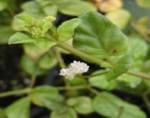Scientific Name: Boerhavia repens
Indigenous
Description: Somewhat succulent herbs with a thick center root from which prostrate stems branch out radially. Leaves are small and rounded. From the leaf axis, small white flower clusters extend up from a single, narrow stem.
Distribution: This native Hawaiian plant is found primarily in coastal areas in both rocky and sandy soil types. They are often found mixed in with other coastal ground covers like Pa’u o Hi’iaka (Jacquemontia ovalifolia), ‘Ilima papa (Sida fallax) and Nehe (Wollastonia integrifolia). They’re found throughout the Pacific islands, and here in Hawaii they’re found on all the main islands, as well as most of the Northwestern Hawaiian islands.
Cultural Uses: The succulent roots of Alena are used as a diuretic.
Landscaping Uses and Care: Alena looks great in landscapes that incorporate a lot of rocks. Their light green foliage and white flowers contrast nicely with the rocks, and make the rocks stand out. Plant them in full sun with about a one foot spacing to ensure a full look. Daily watering is OK as long as the plants are in well-drained soil. Otherwise, water them once the soil has dried. After the plants are established, watering can be reduced to about once a week or a little more frequently if conditions are dry.
Additional Information: There are four species of Boerhavia found in Hawaii; all but one are native and all have small sticky fruit that make the plant easily dispersible. The single non-native species (Boerhavia coccinea) has the stickiest and produces the most seeds, which usually stand higher off the ground than the other plants’, making them easier to attach to passing people, animals, vehicles, etc. The germination rate of the seeds is also high and they become well-rooted, making them a tough weed. It’s no wonder why this plant, although a recent introduction, is well-established and widespread.
Alena
